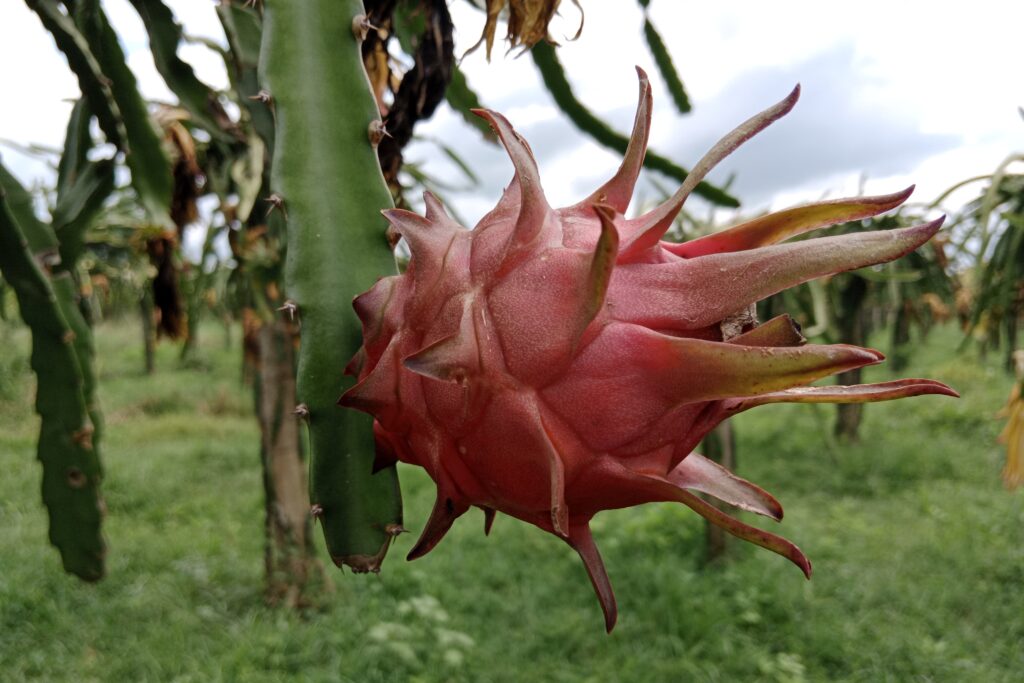Pak Choi farming
Pak choi (Brassica rapa subsp. chinensis), synonymous with bok choy and Chinese cabbage, is a rapidly developing leafy vegetable suited to cool seasons. It is distinguished by its crisp petioles and delicate, mildly flavored leaves. Belonging to the Brassicaceae family, it offers notable nutritional benefits, including vitamins A, C, and K, and calcium. Due to its flexibility in cooking—frequently used in salads, soups, and stir-fries—it enjoys consumer favor. The crop’s capacity to flourish under a range of conditions underpins its widespread cultivation in both domestic gardens and commercial operations.
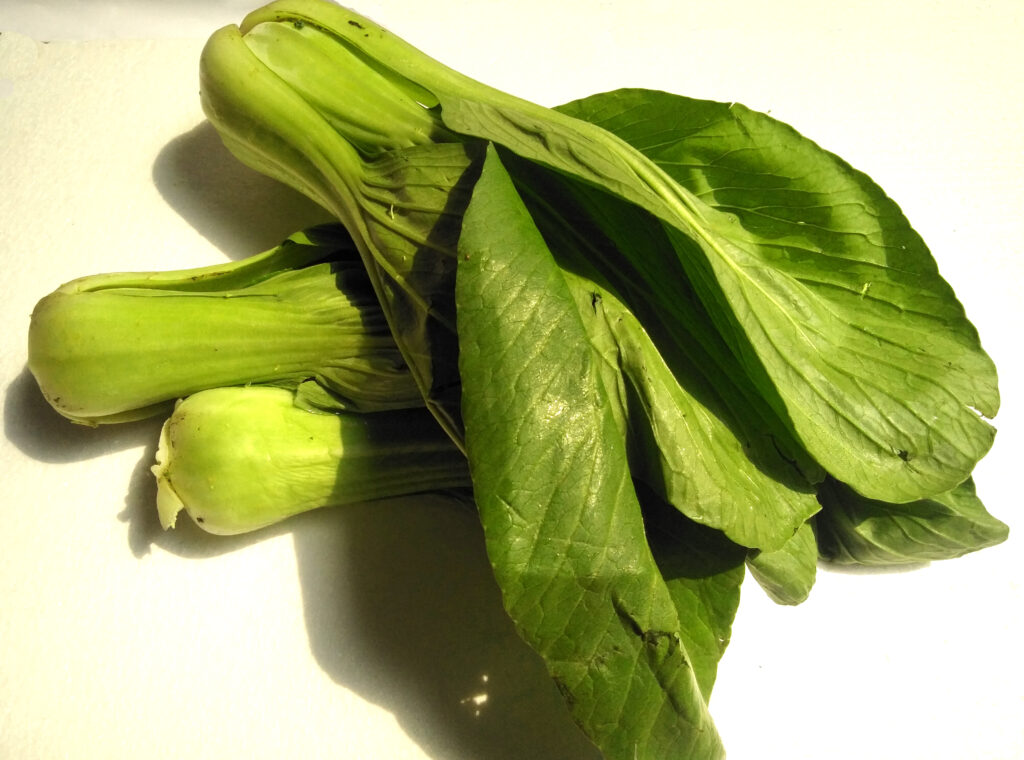
In terms of commercial viability, Pak choi farming profit per acre is highly attractive for growers. With a total income of around NRs. 280,000 against a cultivation cost of just NRs. 54,000, farmers can achieve a net profit of about NRs. 226,000 per acre.
The benefit-cost ratio (B:C) stands at 5.18, meaning every rupee invested yields a return of about 5.2 rupees, while the net return per kilogram is approximately NRs. 28.25. These impressive figures underline the profitability of pak choi cultivation, proving it to be a lucrative venture for farmers, particularly when efficient practices in soil preparation, irrigation, fertilization, and pest management are followed.
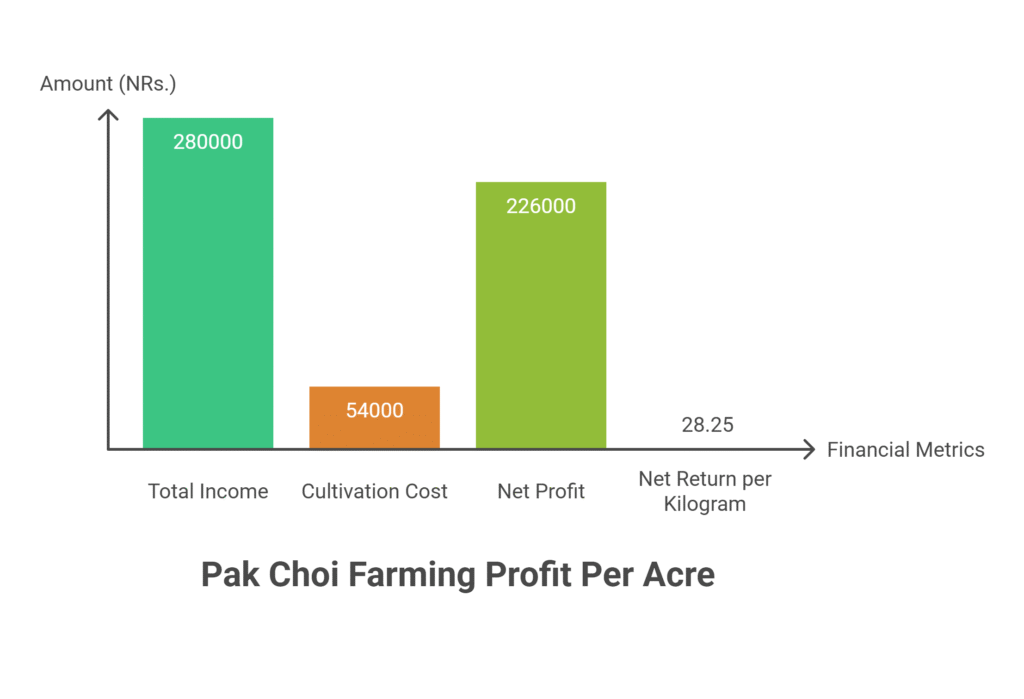
Land Preparation
Land preparation aims to create a fine, well-drained, and weed-free seedbed, beginning with deep plowing to a depth of 15–20 cm to break compacted soil and incorporate crop residues or organic matter, followed by 2–3 cross harrowings to crush clods and refine the tilth. The field is then leveled to ensure uniform water distribution and avoid waterlogging, after which beds are formed according to soil type and irrigation method. Raised beds (15–20 cm high and 1–1.2 m wide) are recommended in heavier soils or rainy seasons to enhance drainage, while flat beds may be used in well-drained soils, ensuring the beds remain firm but not overly compacted.
Soil Type
While deep, fertile, well-drained, organic-rich loam is ideal, this crop tolerates a spectrum from sandy loam to clay loam, provided drainage is adequate. Avoid poorly drained heavy clay, as it promotes root diseases. For best results, maintain a slightly acidic to neutral pH (6.0-7.0). If pH drops below 5.5, liming is recommended to combat clubroot disease favored by excessive acidity.
Climatic Requirements
Pak choi is a cool-season vegetable that performs best at temperatures of 15–20°C, with seeds germinating within a range of 10–30°C and an ideal range of 20–25°C. It grows well in cool, moist environments but is very prone to bolting, which may occur due to extended exposure to temperatures below 10°C in young plants, abrupt changes from cool to warm conditions, or long days combined with higher temperatures.
Although it thrives in full sunlight, providing light shade in hotter climates helps minimize bolting, and maintaining steady soil moisture is essential, since water stress restricts growth while excessive humidity can raise the risk of disease.
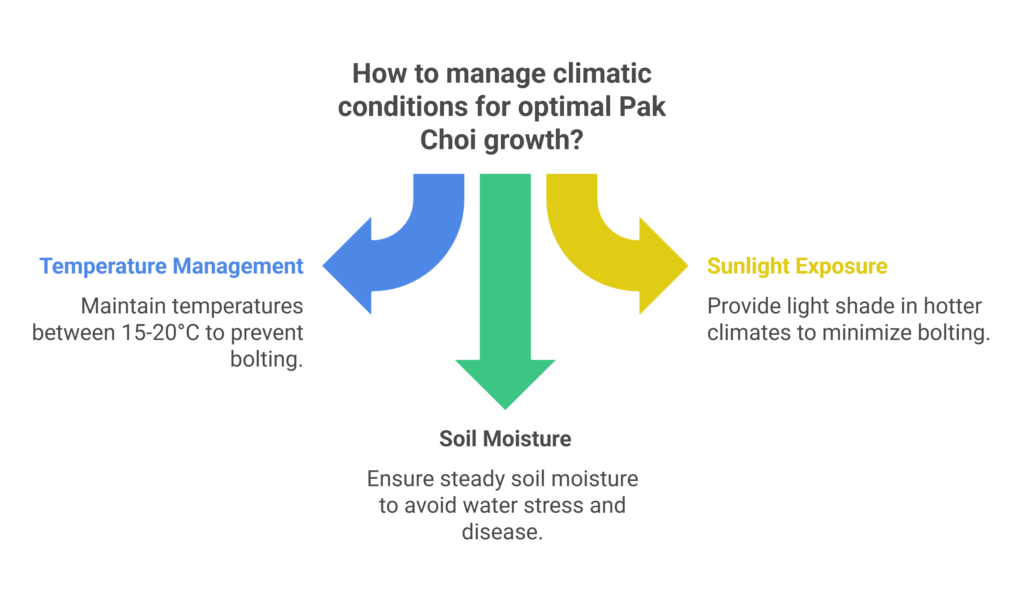
Major Cultivars
Table 1: Major Pak Choi Cultivars Grouped by Stalk Color
| Stalk Color Group | Characteristics | Example Cultivars |
| White/Pale Green Petiole | Most common commercially | ‘Joi Choi’, ‘Shanghai’, ‘Mei Qing Choi’ |
| Green Petiole | Often smaller; sometimes more bolt-resistant | ‘Canton Pak Choi’ |
Table 2: Major Pak Choi Cultivars Grouped by Size/Maturity
| Size/Maturity Group | Characteristics | Example Cultivars |
| Baby/Small Type | Harvested very young (15-20 cm tall); Fast-maturing (30-35 days); High density planting | ‘Baby Choi’ |
| Standard/Full-Size Type | Larger heads; Take longer to mature (45-60 days) | ‘Joi Choi’, ‘Tai Sai’ |
Table 3: Bolt Resistance in Pak Choi Cultivars
| Trait | Importance | Example Cultivar with Trait |
| Bolt Resistance | Crucial for extending growing seasons (especially spring planting) | Mei Qing Choi’ (known for good bolt resistance |
Propagation
Propagation of pak choi is done exclusively through seeds.
Seed Rate per Acre
The seed requirement for pak choi is about 400–600 grams per acre.
Planting
Planting Season
The ideal planting season for pak choi is from August to December.
Spacing
The recommended spacing for pak choi is 10 cm × 10 cm for baby varieties and 25 cm × 25 cm for standard varieties.
Planting Method
For direct seeding, sow pak choi seeds 0.5–1 cm deep, placing 2–3 seeds per station at the final spacing, then thin to the strongest seedling after emergence, or alternatively, sow in closely spaced rows and thin later.
Number of Plants per Acre
| Pak Choi Type | Number of Plants per Acre |
| Baby Pak Choi | 404,700 |
| Standard Pak Choi | 64,752 |
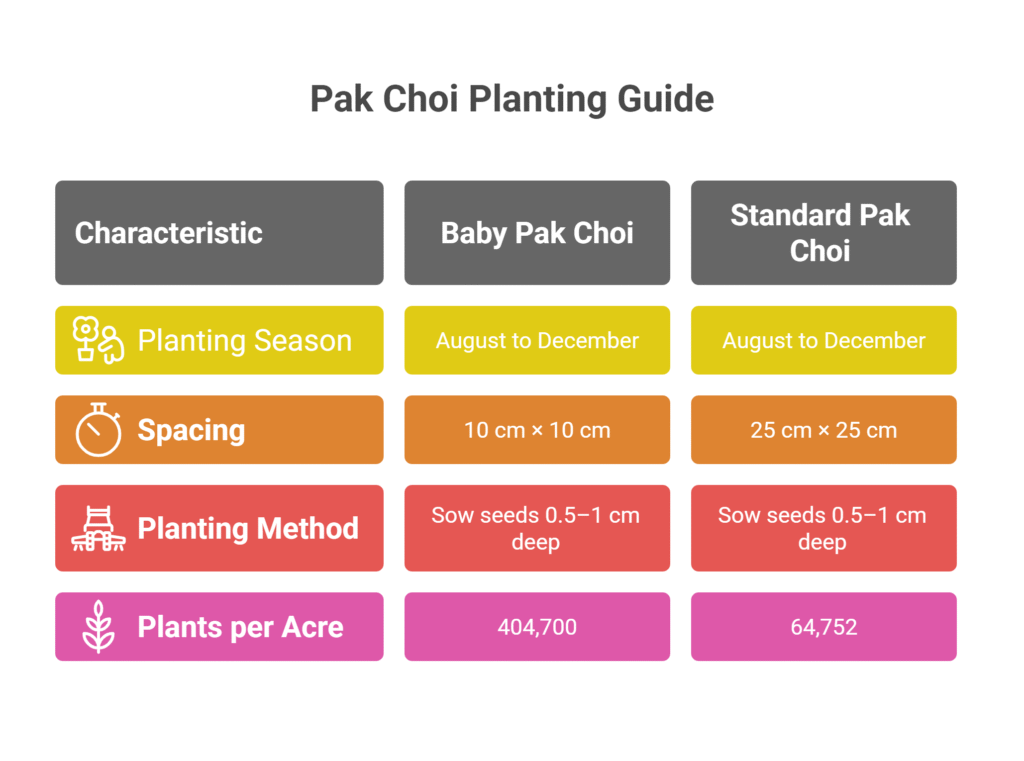
Intercropping
Pak choi can be intercropped with slower-growing or taller crops such as tomatoes, peppers, and corn, as well as with onions, garlic, aromatic herbs that help deter pests, radishes, and bush beans, while other brassicas like cabbage, broccoli, and kale should be avoided due to shared pests and diseases. Intercropping maximizes land use, provides potential pest deterrence, and offers shade during warmer periods, but it is important to ensure sufficient space and resources, including light, water, and nutrients, for both crops to thrive.
Irrigation
Consistent irrigation is critical for pak choi to ensure rapid growth and tender leaves and stalks, as water stress can cause bolting and bitterness. Light, frequent watering every 2–3 days during dry periods is preferred over infrequent heavy soakings, with adjustments made for soil type—sandy soils requiring more frequent irrigation—and prevailing weather conditions.
Drip irrigation is highly recommended for its water efficiency, ability to target the root zone, and reduced disease risk, while overhead sprinklers are acceptable but may increase disease incidence. Waterlogging should be avoided, as it promotes root rot.
Fertilizer and Manure
Pak Choi Fertilization Schedule (per acre basis)
| Application Timing | Fertilizer Type | Specific Materials / Strains | Application Rate | Method & Key Notes |
| Land Preparation | Organic Manure/Compost | Well-decomposed FYM or Compost | 15-20 tons | Incorporate thoroughly during land preparation. Ensure good nutrient balance. Other organics (blood meal, fish emulsion, seaweed) can supplement. |
| Pre-planting | Biofertilizers | Azospirillum | 500g | Mix 10–12 kg of compost or sand and apply it per acre of land. |
| PSB (Phosphate Solubilizing Bacteria) | 500g | |||
| Potash Mobilizing Bacteria | 500g | |||
| At Planting | Chemical Fertilizer (NPK) | NPK (e.g., 19:19:19, 17:17:17, or similar) | 50 kg N, 50 kg P₂O₅, 50 kg K₂O | Apply based on soil test recommendations. Incorporate into soil before planting or transplanting. |
| Top Dressing (Post-planting) | Nitrogen Fertilizer | Calcium Ammonium Nitrate (CAN) or Urea | 25-35 kg N (total) | Apply 3-4 weeks after planting or thinning. Split into 2 applications (e.g., 15-20 kg N each) for longer-season standard types. Avoid excessive N close to harvest. |
Weed Control
Weed management is critical for pak choi, as weeds compete intensely for light, water, and nutrients in this fast-growing crop. Effective methods include shallow cultivation using a hoe around small weeds while avoiding damage to shallow roots, hand weeding near the plants, and mulching with organic materials like straw, hay, or compost—or black plastic mulch—after transplanting or thinning to suppress weeds, conserve moisture, and moderate soil temperature.
Chemical herbicides should be used with extreme caution due to the crop’s sensitivity, and only pre-emergent herbicides labeled for leafy brassicas should be applied when weeds are severe, preferably under guidance from local experts.
Flowering Management
Flowering management in pak choi is primarily aimed at preventing premature bolting, which causes the leaves and stalks to become bitter and tough, drastically reducing the crop’s quality and marketability. Careful control of environmental and cultural conditions is therefore crucial to ensure that the plants remain in their desirable vegetative stage for harvest.
To manage bolting, farmers should select bolt-resistant varieties, especially for spring planting, and choose planting seasons during consistently cool periods, such as fall. Maintaining steady moisture and fertility while avoiding root disturbance helps minimize stress that can trigger bolting. In warmer spring conditions, using 30–50% shade cloth can delay bolting, and prompt harvesting before bolting occurs is critical, as the quality of the crop declines rapidly once flowering begins. No fruit management is required for pak choi.
Pest and Disease Management
Common Pests
Aphids
Insects known as aphids feed on sap and cause pak choi leaves to curl, distort, and develop more slowly. They can be controlled by misting neem oil (2–3 ml per liter of water) or insecticidal soap (2–3% concentration). Biological control is achieved by introducing natural predators like ladybugs, while a powerful water spray can help remove aphids from plants. Licensed systemic insecticides may be used in severe infestations in accordance with the directions on the manufacturer’s label.
Flea Beetles
These tiny jumping beetles create small “shot holes” on leaves, reducing photosynthesis and plant vigor. Effective control methods include using row covers to exclude beetles, applying diatomaceous earth around the base of plants, or spraying with spinosad at 0.5 ml per liter or pyrethrin-based insecticides at recommended doses. Regular monitoring is essential to detect early infestations.
Cabbage Loopers and Imported Cabbageworms
Green caterpillars feed on large areas of foliage, leaving significant damage. Management includes hand-picking caterpillars, applying Bacillus thuringiensis (Bt) at 2–3 g per liter of water, or using spinosad at 0.5 ml per liter. Sprays should target the undersides of leaves where larvae feed, and applications may need repeating every 7–10 days if infestations persist.
Cutworms
These pests sever seedlings at the soil line, often causing plant death. Preventive measures include placing collars around transplants, tilling soil before planting to expose larvae, and using cutworm baits according to label instructions. Early detection and removal of affected seedlings help minimize crop loss.
Slugs and Snails
These mollusks chew irregular holes in leaves, especially under moist conditions or on young plants. Control options include beer traps, spreading diatomaceous earth around plants, applying iron phosphate baits at 5–10 g per square meter, and hand-picking during early morning or evening hours. Maintaining good field sanitation and reducing excess moisture also helps limit infestations.

Common Diseases
Damping Off (Pythium, Rhizoctonia)
This disease causes seedlings to collapse suddenly, often at the soil line, leading to significant losses in young plants. Prevention is critical and includes using well-drained soil, avoiding overwatering, and sowing in a sterile seedling mix. Seeds can be treated with fungicides such as metalaxyl or captan at recommended seed treatment doses (e.g., 2–3 g per kg of seed) before sowing to reduce infection risk.
Downy Mildew
In cool, damp weather, downy mildew is characterized by yellow areas on the upper leaf surface with a purple-grey mold underneath. When possible, plant resistant cultivars; make sure plants have adequate airflow; and refrain from using overhead irrigation. Fungicides based on copper, like copper oxychloride (2 g per liter of water), can be used at the onset of infection or as a preventative measure. They can be repeated every 7–10 days as necessary.
Alternaria Leaf Spot
This fungal disease produces dark brown, target-like spots with concentric rings on leaves, reducing photosynthesis and plant vigor. Management includes practicing crop rotation, promptly removing infected plant debris, and applying fungicides such as chlorothalonil at 2 g per liter of water or copper-based fungicides at 2 g per liter. Applications should be repeated every 7–10 days during favorable conditions for disease development.
Clubroot (Plasmodiophora brassicae)
Clubroot causes swollen, distorted roots and stunted plants, with severity increased in acidic soils. Effective control involves long crop rotations of 4–7 years away from brassicas, raising soil pH to 7.0–7.2 using lime, improving drainage, and planting resistant varieties where available. In extreme cases, soil fumigation may be considered.
Soft Rot (Bacterial)
Soft rot manifests as watery, slimy decay, often beginning at the plant base or damaged areas. To manage it, avoid mechanical injury to plants, maintain good drainage and airflow, harvest carefully, and avoid overhead irrigation late in the day. Proper sanitation, including removal of infected plant material, is essential to prevent spread.
Harvesting
Harvest pak choi when the plants have reached the desired market size and remain compact and tender. Baby varieties are ready for harvest at 15–25 cm tall, typically 30–40 days after planting, while standard varieties reach harvestable size at 25–40 cm tall, usually 45–60 days after planting.
Pak choi is typically harvested by cutting the whole plant at its base with a sharp knife and discarding damaged outer leaves. While a selective leaf-by-leaf (cut-and-come-again) technique is possible for loose-leaf types or home use—enabling regrowth from the center—it generally results in a lower total harvest volume compared to single-cut harvesting.
Harvesting is best carried out early in the morning when plants are crisp and cool, and wet leaves should be avoided to minimize disease spread.
After harvesting, pak choi should be cooled immediately using hydro-cooling or forced-air methods to near 0°C (32°F) while maintaining high humidity (95–100%). Plants should be packed loosely in crates or cartons to prevent crushing, keeping in mind that the crop has a relatively short shelf life of 1–2 weeks under ideal conditions.
Yield
The typical yield of pak choi varies by variety, with baby pak choi producing approximately 5,000–10,000 kg per acre, while standard pak choi yields are higher, ranging from 10,000 to 15,000 kg per acre.
Cost of Investment Per Acre for Pak Choi Farming
| S.N. | Categories | Cost (NRs.) |
| 1 | Land Preparation (plowing) | 15,000 |
| 2 | Seed | 3,000 |
| 3 | Sowing | 5,000 |
| 4 | Fertilizers and Manure | 10,000 |
| 5 | Irrigation | 5,000 |
| 6 | Weed Control (pre & post) | 3,000 |
| 7 | Pest & Disease Control | 3,000 |
| 8 | Harvesting | 5,000 |
| 9 | Miscellaneous Costs | 5,000 |
| Total Cost of Cultivation | 54,000 |
Income from Per Acre Pak Choi Farming
| Particulars | Estimated Yield (Kg/acre) | Market Price (NRs/kg) | Total Income (NRs.) |
| Fresh Leaf Yield | 8,000 | 35 | 280,000 |
Analysis of Pak choi Farming Profit Per Acre
The profit analysis of Pak Choi farming shows that with a total income of NRs. 280,000 and a cultivation cost of NRs. 54,000, farmers can earn a net profit of about NRs. 226,000 per acre. The benefit-cost ratio (B:C) is approximately 5.18, meaning that for every 1 rupee invested, farmers receive about 5.2 rupees in return. Additionally, the net return per kilogram of Pak Choi is around NRs. 28.25, highlighting its strong profitability. Overall, Pak Choi cultivation proves to be a highly lucrative venture, offering significant returns when managed efficiently with proper input use, irrigation, and pest control.
Crop Calendar for Pak choi Farming
| Stage | Timing | Key Activities | Duration |
| Land Preparation | Late July – Early August | · Deep plowing (15-20 cm) · 2-3 harrowings for soil tilth · Bed formation (raised/flat) · Apply 15-20 tons compost/FYM | 7-10 days |
| Seed Sowing | August – December | · Direct seeding (0.5-1 cm depth) · Spacing: 10×10 cm (baby) / 25×25 cm (standard) · Seed rate: 400-600 g/acre | 1-2 days |
| Seedling Emergence | 4-7 days after sowing | · Thin seedlings (retain strongest) · Monitor damping-off disease | N/A |
| Vegetative Growth | Weeks 1-6 | · Fertilizers: Top-dress N (25-35 kg/acre) at 3-4 weeks · Irrigation: Light watering every 2-3 days · Weed Control: Mulching/shallow cultivation · Pest Control: Monitor aphids/flea beetles | Weeks 1-4 (baby) Weeks 1-6 (standard) |
| Bolting Prevention | Throughout growth | · Maintain soil moisture · Use shade cloth (if >20°C) · Avoid root disturbance | Continuous |
| Harvesting | 30-60 DAP | · Baby Pak Choi: 30-40 DAP (15-25 cm tall) · Standard Pak Choi: 45-60 DAP (25-40 cm tall) · Cut at base; cool immediately | 1-3 days |
| Post-Harvest | Immediately after harvest | · Hydro-cooling to 0°C · Loose packing in crates · Shelf life: 1-2 weeks | 24 hours |
Sources
Food and Agriculture Organization (FAO)
University of California Agriculture & Natural Resources (UC ANR)
European Plant Protection Organization (EPPO)
Punjab Agricultural University (PAU)
Tamil Nadu Agriculture University (TNAU) – Agritech portal
Indian Council of Agricultural Research (ICAR)
Nepal Agricultural Research Council (NARC)
U.S. Department of Agriculture (USDA).
Disclaimer: This crop farming profits assume optimal conditions. Actual results may vary depending on climate, market prices, and farm management practices.

